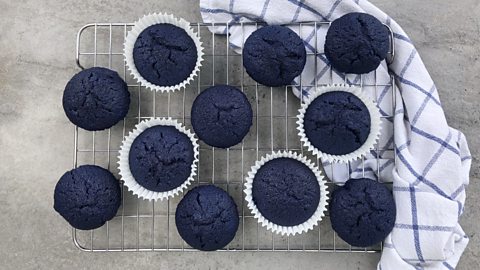Why are people dyeing their poo blue?
Social media users have been posting pictures of vibrant-blue cupcakes with the unique hashtag #bluepoopchallenge. Yep, that’s right. Blue. Poop. Challenge. This didn’t start off as a viral social media trend, but as research into how well your digestive system and gut microbiome are working. And it’s something we can all try.
The time it takes from eating food to excreting it is called the “gut transit time”. Researchers gave participants muffins dyed with strong blue food colouring, turning their poo blue, to make it easy to identify the transit time.
“Slower transit time is associated with less favourable gut bacteria and a faster transit time is associated with a better gut bacteria profile”, explains dietitian and intestinal specialist Sophie Medlin (who wasn’t involved with the study). However, a transit time that’s too fast (suggesting you have diarrhoea) may indicate a less healthy gut microbiome.
The median gut transit time in the study was 28.7 hours, but it can take less than 12 hours and up to several days. “A gut transit time of 14–58 hours is a good place to be, and indicates that your gut is working as it should”, says the website of ZOE, a health science company linked to the research and encouraging people to take up the challenge. But ZOE and Medlin stress “it’s important to know what is normal for you”, as transit time is affected by many factors.
The challenge is not medical advice and doesn’t aim to diagnose, prevent or treat any disease. But at the very least it’s an interesting way to start a conversation about gut health.
How to dye your poo blue

Bake muffins made with blue food colouring. You need to use a professional gel/paste rather than a water-based version, according to the researchers. The original recipe calls for 6g of blue food dye to make 12 muffins. Eat two of the muffins for breakfast and note down the time and date. Check your poo for a blue or green-blue tinge and write down what time you see it. Work out how many hours it has been since you ate the muffins. This is your gut transit time.
Be careful when making these muffins, as although it can be funny to have a bright blue tongue, food dye can stain hands, clothes, your work surface and many other things it comes into contact with. Another effect of using this much food dye is that you may be able to taste the additive, which isn’t pleasant.
Does it work with other foods?
Blue dye can be added to other foods too, as long as you eat 1g food colouring in one sitting. “You can use whatever recipe you like to do the #bluepoopchallenge as long as the dye quantity is kept the same”, the ZOE team wrote in a Tweet. Some Twitter users have shown off their alternatives.
What can you do to improve your gut bacteria?
There’s no “strong evidence” for what people should do about having a slower transit time, says Medlin, but research suggests diet is an effective way to shape the health of your gut microbiome.
Everyone’s gut is different, but some principles apply to all: eating fibre, plenty of vegetables and probiotic foods – live bacteria found in fermented foods such as yoghurt, kimchi and sauerkraut – might encourage healthy microbes to grow. Avoiding highly processed foods and choosing extra-virgin olive oil over other fats when you can as it contains the highest number of microbe-friendly polyphenols, is also advised.
Though changes to your gut bacteria can happen within days, long-term benefits may take several months to show. Microbes can also return to their original make-up if you return to a less beneficial diet.
Under 18s
Under 18s cannot add their results to the experiment on the ZOE Blue Poop Challenge website.